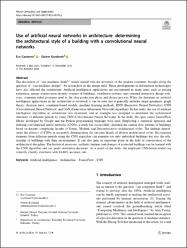Use of artificial neural networks in architecture: determining the architectural style of a building with a convolutional neural networks
Özet
The discussion of ‘‘can machines think?’’ which started with the invention of the modern computer, brought along the
question of ‘‘can machines design?’’ by researchers in the design field. These developments in information technologies
have also affected the architecture. Artificial intelligence applications are encountered in many areas such as pricing
estimation, energy conservation security systems of buildings, ventilation systems, user-oriented interactive design solutions, computer-aided programs used in the plan production phase and design process. When the literature on artificial
intelligence applications in the architecture is reviewed, it can be seen that it generally includes shape grammars, graph
theory, decision trees, constraint-based models, machine learning methods, RNN (Recursive Neural Networks), CNN
(Convolutional Neural Network) and GAN (Generative Adversarial Network) algorithms. In this study, the use of artificial
intelligence algorithms in architecture was examined, and an example was designed to determine the architectural
structures of different periods by using CNN (Convolutional Neural Network). In the study, the open source TensorFlow
library developed by Google and the Python programming language were used. Employing a statistical approach and
utilizing convolutional neural networks (CNNs), a study has successfully classified the current flow patterns of buildings
based on datasets comprising facades of Gothic, Modern, and Deconstructivist architectural styles. The findings demonstrate the efficacy of CNNs in accurately distinguishing the intricate details of diverse architectural styles. Recognizing
elements from different periods using the CNN algorithm can examine not only individual buildings but also the relationship of buildings with their environments. It can also gain an important place in the field of conservation of the
architectural discipline. The historical processes, aesthetic features and changes of protected buildings can be learned with
the CNN algorithm and can guide restoration decisions. As a result of the study, the employed CNN-based model can
correctly classify structures with 84.66% accuracy rate.

















